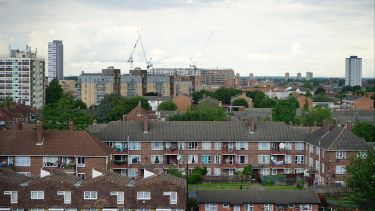Permitted development rights allow property owners to make certain building changes and changes of building use without having to make a planning application.
The government has continued to expand the permitted development rights with a series of regulation changes beginning in 2005 to encourage changing agricultural, industrial and office space into residential housing.
Developers and agents cite many policy benefits including delivering more housing units, regeneration of town and city centres, and quicker implementation.
The research, commissioned and published by the Royal Institute of Chartered Surveyors (RICS), examined five local authorities with high rates of permitted development schemes: Camden, Croydon, Leeds, Leicester, and Reading.
Site visits to 568 buildings in these authorities found an inconsistency in the quality of developments, with only 30% of units built through permitted development schemes meeting national space standards.
The report notes: “While examples of extremely high-quality housing conversions were found, there were also examples that had no amenity space, low quality design and were poor locations for residential amenities.”
Researchers also found that office-to-residential under permitted development had produced a higher number of poor quality housing than those governed through full planning permission. In Glasgow, where the conversions require full planning permission, the report found higher quality residential schemes maintained with better space standards.
The potential impact on local infrastructure was also highlighted. As developers are not required to contribute to local publically funded infrastructure under the scheme, local authorities faced a potential loss of £10.8 million as well as a £4.1m loss due to reduced planning fees.
The report makes a number of recommendations including:
- Amending Community Infrastructure Levy regulations so that all development creating new residential units are liable to make payments
- Government reregulation, or introducing safeguards to the prior approvals process such as adding minimum space standards
- Developers giving careful consideration to the wider implications of their schemes on communities and people’s everyday quality of life
Professor John Henneberry, Professor of Property Development in the Department of Urban Studies and Planning, said: "Planning regulation was reduced by the recent significant extension in permitted development rights. The expectation was that developers large and small would exploit this additional freedom to produce more dwellings.
“This occurred. Tens of thousands of dwellings were realised through the exercise of permitted development rights since they were expanded in 2013/14.
“While the issues raised by large office to residential conversions have been the subject of much continuing debate, the other outcomes of this deregulation have not received such attention.
“Yet the number of dwellings resulting from small scale conversions of offices and other non-residential buildings to housing, and of agricultural buildings to housing, have both individually exceeded those resulting from large scale office to residential developments. This highlights the need to learn more about the impacts of these diffuse, incremental changes."
Dr Ben Clifford, Senior Lecturer, UCL Bartlett School of Planning said: “The idea of reusing vacant office space as housing is a good one. The way this is currently governed as ‘permitted development’ in England is, however, highly problematic.
“Whilst we saw some high quality conversions of office buildings to residential use during our detailed case study research, we also saw many other examples of very poor quality housing.
“These issues included problems over external design, location, residential amenity and the size of the housing units leading to strong concerns about the quality of life for residents.
“Furthermore, there were examples of adverse impacts for local businesses from the conversion of occupied office space to housing, and none of these conversions were contributing properly towards local affordable housing need, the costs of public infrastructure associated with the additional housing units, or the costs of local authority monitoring of these schemes. We believe there is a need for a better regulatory approach to the change of use of office space to housing.”

